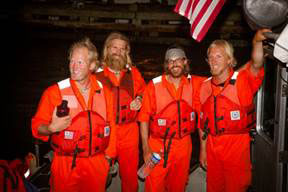Jordan Hanssen is a a rower, adventurer and author and we’re big fans. He’s appearing this Friday at Seattle’s Fisheries Supply, accepting an honor and providing a first hand account of what it’s like to really use survival equipment. He gave us a little preview by email:
“I hope you can pass along the attached press release. OAR NW, Fisheries Supply, ACR-Artex (maker’s of those little Personal Locator Beacons that saved us) and Mustang Survival are doing a program on Friday at Fisheries.
Basically, ACR runs an educational outreach program called the “survivors club.” If you choose to share your story of survival you get your beacon replaced.
Granted its a club that raises awareness about beacons (which they sell) but the reality is these things are small (size of an old Nokia), cheap, durable, they work anywhere, and they have a track record of saving lives and money (tax payer and otherwise) spent on searches.
I’m not getting paid anything (except my beacon replaced) for this. I just think its a really important tool, up there with having a GPS, if you are going into a potentially dangerous environment. We spent 12 hours instead of a 24 or more in a life raft because we used em. Even the Coast Guard noted on our level of preparedness.
They run on cospas-sarsat satilite system which is a international organization of 43 countries (including Russia and China) whose objective is to find lost people. The technology is pretty sci-fi amazing and kinda feels like a warm fuzzy win for humans helping humans across culture and language barriers.
I felt like this is worth sending your way considering how may boaters, hikers, and general adventure types we have in our community. Even if you don’t do the story its something you guys should consider if you’re heading out to the boonies.
Long story short I would take a PLB over a liferaft in a situation where my boat was upside but still floating in 78 degree water. That wouldn’t be the case in other areas. Especially up here, 12 hours of exposure would have killed us. In our situation, was I glad to have both. If you have 5k to spend on a decent liferaft, you should drop 350 bucks (or maybe that x each of your crew) its worth it.”
The Press Release from Fisheries Supply
Jordan Hanssen, OAR Northwest (www.oarnorthwest.com) Captain will be at Fisheries Supply on September 13, from 10-1PM for a presentation at Noon by ACR to acknowledge their membership in the Survivor Club (www.survivorclub.com ). Jordan and his three fellow crewmembers were in their 29 foot row boat on the Canadian Wildlife Federation’s Africa to the Americas science and education expedition. They were attempting the first unassisted rowing expedition from the coast of Africa to mainland North America. 2,700 nautical miles into the expedition, the ocean had other plans.
850 miles from their destination of Miami, two successive waves capsized the boat into a position that the crew’s self righting boat was unable to do so. They activated their ACR, GPS ResQLink, GPS personal locator beacon which alerted the United States Coast Guard, donned their Mustang Survival PFDs and deployed their life raft. For three hours the crew attempted unsuccessfully to right their boat. Due to the crew’s extensive safety planning prior to the launch, the USCG was able to locate the team in less than six hours and coordinate a rescue with a 580 ft. car carrier M/V Heijin in 13 hours. Jordan will share the details of their trip including the rescue.
Jordan and the boat used in the expedition will be at the presentation. He will also have copies of his book, ‘Rowing into the Son,’ about his Guinness world record crossing in the worlds first the North Atlantic rowing race from New York to England. (www.rowingintotheson.com).
BACKGROUNDER
CWF Africa to the Americas Expedition Facts:
• The expedition’s estimated distance was 6,700 km or 3,659 nautical miles
• The ocean rowers burned 6,000 – 10,000 calories a day
• The estimated crossing time was 60-100 days)
• The rowers recorded scientific data, blog and upload photos and videos to OARNorthwest.org
• There was no support ship following the crew, but the team received deep sea survival training, safety
equipment, a satellite phone and GPS tracking.
• The rowboat is equipped with a desalination unit to convert salt water to fresh for drinking,
a wind turbine and solar panels to power research and communications equipment
• OAR Northwest successfully completed a training expedition around Canada’s Vancouver
Island, the CWF Salish Sea Expedition, in May, 2012.
• OAR Northwest won the inaugural 2006 North Atlantic Rowing Race between New York & Falmouth, England. They set a Guinness World Record for being the first crew to successfully row from mainland USA to mainland UK. They won the race by over 250 miles, and 1.5 weeks.
ABOUT OAR NORTHWEST
Founded in 2005, OAR Northwest is a non-profit organization specializing in Ocean Adventure
Rowing and Education. OAR Northwest connects with partners to propel youth, schools, community members and businesses to showcase the outdoors, marine habitat and healthy lifestyles. Face-to-face interactions with expedition crew members, innovative online tracking technology and an adventure learning curriculum help OAR Northwest achieve these goals. For more information, visit www.OARnorthwest.org. For the adventure learning curriculum, signup at www.OARnorthwest.org/education
